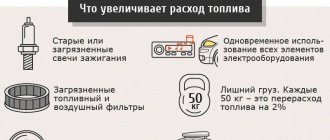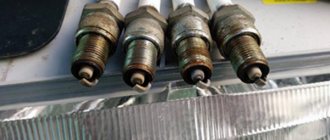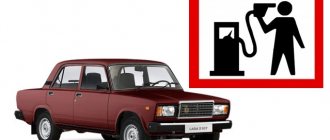10-14 6-9 Mitsubishi
15.07.2016
- Mitsubishi Lancer 8th generation Reviews of real consumption of Mitsubishi Lancer VIII
- Reviews of the real consumption of Mitsubishi Lancer IX
- Reviews of the real consumption of Mitsubishi Lancer X
The history of Mitsubishi Lancer begins in 1973. Consumers can choose a car body type from the following options: sedan, hatchback, station wagon and coupe. Throughout its existence, cars have been sold under different names in different countries.
Mitsubishi Lancer was produced in several generations, the first generation of which was released from 1973 to 1976. The production of cars of the latest, tenth, generation began in 2007 and continues at the present time.
Japanese company Mitsubishi
But first, let's say a few words about the company that produced this incredibly stylish and powerful car. Mitsubishi Motors Corporation is a famous Japanese company engaged in the creation of automobiles. It is believed that its founder was Yataro Iwasaki. It is the image of his family coat of arms that underlies the Mitsubishi symbol. This is the well-known shamrock - three diamond-shaped oak leaves arranged in the shape of a flower. The company's headquarters is located in Tokyo.
| Engine | Consumption (highway) | Consumption (city) | Consumption (mixed cycle) |
| 1.6 MIVEC 5-mech | 5.2 l/100 km | 8 l/100 km | 6.2 l/100 km |
| 1.6 MIVEC 4-auto | 6.1 l/100 km | 8 l/100 km | 7.3 l/100 km |
| 1.5 MIVEC | 6 l/100 km | 8.9 l/100 km | 7 l/100 km |
| 1.8 MIVEC | 6.1 l/100 km | 10.3 l/100 km | 7.6 l/100 km |
| 2.0 MIVEC | 6.6 l/100 km | 10.8 l/100 km | 8.1 l/100 km |
| 2.4 MIVEC | 8.4 l/100 km | 11.2 l/100 km | 10.2 l/100 km |
| 1.8 DI-D | 4.4 l/100 km | 6.2 l/100 km | 5.2 l/100 km |
| 2.0 DI-D | 5.2 l/100 km | 8.5 l/100 km | 6.4 l/100 km |
| 1.8 DI-D | 4.8 l/100 km | 6.8 l/100 km | 5.5 l/100 km |
Now the company is developing steadily. It has produced several world-famous series of machines that are respected throughout the world. These are ASX, Outlander, Lancer, Pajero Sport. One of the features of these cars is economical fuel consumption when driving on the highway.
Over the course of a year, the company manages to produce more than one and a half million “iron horses,” which are sold in one hundred and sixty countries around the world. And this is not the limit. The company continues to increase its turnover.
How much does the subcompact version consume?
If you are one of those who prefer to save on servicing a Lancer, purchase a modest and low-power 1.3 liter version with an engine of just 83 horsepower. Statistics for this configuration indicate that, according to official data, again, a car with such an engine should “eat” a maximum of 8.6 liters. Having turned to the owners for feedback, we find that in reality it comes out to 9.63 when driving around the city. If you have your own excellent data, write to us.
With this we will say goodbye, friends. There are many other useful discussions ahead of us regarding fuel consumption of other car brands, and not only. Subscribe to the blog and stay up to date with events. Bye!
Moderators: mek, indy
Very high fuel consumption
#1 Post by hahol_a » November 27, 2012, 07:23
Hi all. Tell me what I need to do to reduce fuel consumption! at the moment the consumption with very quiet driving is 20-22l. in mixed mode. I went for diagnostics and didn’t find out anything useful. The only thing he told me was “high pressure in the gas crankcase ventilation system” without explaining what it was! and he also said that the throttle valve does not adjust! The injectors are normal, the injection pump too! (but not a fact) this is already the second diagnostician said. Out of despair, the catalytic converter blew. (didn’t help) now I’m sinning with lambda! but it costs 7 rubles. I was already tired of reading the forum, after which it was done: the speed was floating and there was still vibration! 1. changed the gasket, well seals 2. spark plugs 3. rollers and timing belt. (three oil seals) hydraulic tensioner 4. changed three gasoline filters! 5. air filter! 6. cleaned the throttle valve! 7. The catalyst has broken.
In this case, the check does not light up, and the diagnostics does not produce errors.
and maybe someone from Surgut! tell me a good GDI diagnostician for Mitsubishi Galant 4g94 GDI
Re: Very high fuel consumption
#2 Post by hahol_a » November 27, 2012, 07:25
This is what the diagnostics showed, can anyone help me figure it out? The diagnostician says the lambda does not give any indicators, but the check light does not light up
Re: Very high fuel consumption
#3 Post by f111uzm » November 27, 2012, 10:41 am
Re: Very high fuel consumption
#4 Post by hahol_a » November 28, 2012, 08:24
I went to an electrician, they checked the lambda, it is working. But when I unscrewed it I saw that there was a lot of carbon on it. I cleaned it, I don’t know how long it will last. Maybe my lambda is not selected correctly? Please advise which lambda to buy for this engine? Now it costs Bosch 258006 537 088 i6 (not original)
I went to the stores according to the analogue catalogue, I have a Bosch 602, but on the Galant Club forum they say 133.
who else would recommend?
Re: Very high fuel consumption
#5 Post by ALEX 163 » 28 Nov 2012, 09:48
Re: Very high fuel consumption
#6 Post by hahol_a » November 28, 2012, 4:39 pm
Re: Very high fuel consumption
#7 Post by 19susel90 » November 28, 2012, 05:33 pm
Re: Very high fuel consumption
#8 Post by 19susel90 » November 28, 2012, 6:13 pm
Re: Very high fuel consumption
#9 Post by voteraz » November 28, 2012, 08:49 pm
hahol_a wrote: Hello everyone. Tell me what I need to do to reduce fuel consumption! at the moment the consumption with very quiet driving is 20-22l. in mixed mode. I went for diagnostics and didn’t find out anything useful. The only thing he told me was “high pressure in the gas crankcase ventilation system” without explaining what it was! and he also said that the throttle valve does not adjust! The injectors are normal, the injection pump too! (but not a fact) this is already the second diagnostician said. Out of despair, the catalytic converter blew. (didn’t help) now I’m sinning with lambda! but it costs 7 rubles. I was already tired of reading the forum, after which it was done: the speed was floating and there was still vibration! 1. changed the gasket, well seals 2. spark plugs 3. rollers and timing belt. (three oil seals) hydraulic tensioner 4. changed three gasoline filters! 5. air filter! 6. cleaned the throttle valve! 7. The catalyst has broken.
In this case, the check does not light up, and the diagnostics does not produce errors.
and maybe someone from Surgut! tell me a good GDI diagnostician for Mitsubishi Galant 4g94 GDI
Lancer history
Pioneer
One of the most famous, successful and sought-after Mitsubishi series is Lancer. The first swallow of the line - the A70 model - saw the world at the end of winter 1973. It was produced in the following body styles:
- sedan with 2 doors;
- sedan with 4 doors;
- station wagon with 5 doors.
The engine size also varied (the larger the volume, the greater the fuel consumption):
- 1.2 liters;
- 1.4 liters;
- 1.6 liters.
Generation number two
In 1979, a new Lancer series appeared - EX. At first it was equipped with engines that could have three displacement options:
- 1.4 l (power - 80 horsepower);
- 1.6 l (85 horsepower);
- 1.6 l (100 horsepower).
But, a year later, another Lancer model appeared in the lineup with a more powerful engine - 1.8 liters. In addition, sports cars with other engines were produced.
In terms of fuel consumption, even the second generation Mitsubishi Lancer was very economical. The fuel consumption test, which passenger cars underwent in ten modes, showed fuel consumption of only 4.5 liters per 100 kilometers
. Well, if the Lancer owner drove mainly at a speed of 60 km per hour, then the fuel consumption was 3.12 liters per 100 km.
Third knee
The car of the third “level” appeared in 1982 and was called Lancer Fiore, had two body options:
- hatchback (since 1982);
- station wagon (since 1985).
Such Lancers were produced until 2008. A feature of this line was that the cars began to be equipped with turbocharging, as well as an injector. Like the previous ones, they were equipped with engines of different sizes, on which fuel consumption depended:
- 1.3 l;
- 1.5 l;
- 1.8 l.
Fourth generation
From 1982 to 1988, the fourth “circle” was updated. Externally, these cars began to be distinguished by the presence of diagonal lights. Engine modifications were as follows:
- sedan, 1.5 l;
- sedan, 1.6 l,
- sedan, 1.8 l;
- sedan diesel;
- station wagon, 1.8 l.
Attempt number five
Already in 1983, a new Lancer model appeared. Outwardly, she became much more interesting than her predecessors and almost immediately gained enormous popularity. The car was produced in four body styles:
- sedan;
- hatchback;
- station wagon;
- coupe.
Also, the future owner could choose the desired engine size:
- 1.3 l;
- 1.5 l;
- 1.6 l;
- 1.8 l;
- 2.0 l.
The gearbox could be 4 or 5 speed. Also, some models were produced with a three-speed automatic transmission, which greatly simplified driving.
What engines are installed on the Lancer 10
Mitsubishi Group produces Lancer X cars with a large selection of power plants, satisfying any consumer needs. Engines with a volume of 1.5 liters can provide efficiency, but if the car owner wants to have the most dynamic car, then his choice should be made towards engines of 2.0 and 2.4 liters.
At the beginning of the release of the Mitsubishi Lancer 10, it was planned to start the line of engines with a low-power 1.3 liter engine. Its power was not enough for a fairly dynamic ride, so the manufacturer had to abandon mass production of the Lancer X with such a power unit.
A more powerful engine, which nevertheless made it into mass production, was the 1.5 liter 4G15 engine with a power of 109 horsepower. It provided acceptable overclocking, but its resource was insufficient. This is due to design flaws and the high sensitivity of the engine to the quality of the oil and the frequency of its replacement.
In 2011, to replace the unsuccessful one and a half liter engine, the Mitsubishi Group began installing 1.6-liter power plants on the Lancer X. The power increased to 117 horsepower made the dynamics better and the acceleration to 100 km/h was reduced. The new engine was a success and managed to completely displace the 1.5 liter version in 2012.
The appearance of the Mitsubishi Lancer 10 is sporty, which requires an appropriate power unit in the engine compartment. Therefore, internal combustion engines with even greater power appeared in the lineup. The first of these is a 4b10 engine with a volume of 1.8 liters and 143 horses. The second engine was a two-liter 4b11 engine, which had a power of 150 hp. With. Both engines were developed in close cooperation with Kia-Hyundai specialists, therefore, on the international market they are also called G4KC and G4KD, respectively.
In 2012, the two-liter engine ceased to be used on the Lancer 10. This is due to both the increased taxation of a larger engine and the lower liter power of the power plant.
For the North American consumer, the Lancer 10 is available with an engine capacity of 2.4 liters. The same motor is used on the evolution x. A turbine is also used with it, which allows it to achieve 176 horsepower. Tuning this power plant brings an increase in power up to 190 hp without loss of resource. The engine was developed jointly with Kia-Hyundai and received the international designations G4KE and 4B12.
Mitsubishi Lancer 6
The sixth series first appeared in 1991. The company has provided many modifications to this line. Thus, it was possible to purchase cars with an engine capacity from 1.3 liters to 2.0 liters. The most powerful one ran on diesel fuel, all the others ran on gasoline. They also had slightly different bodies: there were two- and four-door versions, sedans and station wagons.
Lucky number seven
The seventh generation became available to buyers in the early nineties. While maintaining the original design style of its predecessors, the car became even more like a sports car. At the same time, the aerodynamic drag became even lower and reached 0.3. The Japanese improved the suspension and added airbags.
Eighth, ninth and tenth generations
It appeared in the year two thousand. The appearance of the car has become even more interesting and noticeable. Buyers from all over the world can purchase a model with a manual or automatic transmission. This car was produced for three years.
And in 2003, a new product appeared - Lancer 9. Well, ten months later the Japanese improved the “heart” of the car, increasing its volume to 2.0 liters. This car has become very popular.
But even it was “outdone” by the tenth version of Lancer. The company presented several types of engine power and body styles. So anyone who always strives to be on top and keep up with the latest automotive innovations can safely choose Lancer X. This car will emphasize the style, status and good taste of its owner.
Mitsubishi Pajero 3.2
For the first time, a 3.2-liter diesel engine was installed on the third generation Pajero. A few years later, the manufacturer released a fundamentally new turbodiesel with DI-D technology. While the predecessor could boast 170 horsepower, the new engine gained as much as 200 horsepower. As for the transmission, Japanese engineers left everything unchanged: manual and 5-speed automatic transmission. Official gasoline consumption by the engine per 100 km: 13 liters – city, 9 liters – highway.
Reviews from car owners indicate the following actual car fuel consumption:
The 3.2-liter turbodiesel, like its smaller 2.5-liter counterpart, is economical and fully complies with all the characteristics specified in the passport. In addition to acceptable fuel consumption, this engine is also characterized by high build quality and a long service life.
Well, now let’s pay special attention to the latest models of the Japanese automobile industry.
Mitsubishi Lancer 9
Before buying a car, did you read many forums where the “pros” and “cons” of the ninth generation Lancer were discussed? Then, for sure, you know that the manufacturer of this series took good care of the safety of the driver and passengers, equipping the car with a reliable chassis, high-quality suspension, an effective braking system, an ABS system and much more.
The Japanese also did a good job on the engine. It is made of high-quality alloys and has low toxicity. Its use of fuel is very economical, so its consumption is low. If you look at the technical specifications, you will find out that in the ninth generation on average
:
- Mitsubishi Lancer fuel costs in the city are 8.5 liters per 100 kilometers if a manual transmission is installed, and 10.3 liters if automatic;
- The average gasoline consumption of the Lancer 9 on the highway is much less and is 5.3 liters with a manual transmission, and 6.4 liters with an automatic transmission.
As you can see, the car does not “eat” a very large amount of fuel. Actual fuel consumption may differ slightly from the data indicated in the technical specifications.
Mitsubishi Pajero 3.5
The top versions of the SUV were equipped with a 3.5-liter naturally aspirated V6 DGI engine. This gasoline engine was also equipped with a new transmission - the INVECS II adaptive automatic gearbox with the ability to manually change gears. All these innovations allowed the Mitsubishi Pajero to produce power equal to 205 horsepower. The torque is 343 Nm. A top-spec SUV can reach speeds of up to 200 km/h. However, this engine cannot boast of its efficiency: 17 liters per 100 km - urban cycle, 11 liters - suburban cycle.
- Anton, Kyiv. I love big cars with displacement engines, you could say that this is my passion. I switched to Padzherik from a Ford Explorer quite recently. Both cars are good, but I like the Japanese ones better. I’m used to “gluttonous” cars: now the car consumes 20 liters in the city, if you heat it up a little, then 22-23 liters, of course.
- Egor, Rostov. My first car, Mitsubishi Pajero Pinin, is a decent SUV for daily use. But that wasn’t enough for me, I wanted something more powerful. As a result, I now drive a 3.5 liter Pajero purchased on the secondary car market with a mileage of 50 thousand km. The car consumes 18-19 liters in the city, which is higher than the stated norm.
- Ruslan, Moscow. We have two cars in our family – a Range Rover and a Pajero 4. I personally like the “Japanese”, it is simply unrealistically powerful. The car, of course, is not a racing car, but its charge is enough to accelerate well on the track. Optimal consumption while driving on the autobahn can be achieved at a speed of 120 km/h. In the city everything is much worse, no matter how you look at it, it’s never less than 20 liters.
READ Changing the oil in the Mitsubishi Outlander variator
According to the owners, the 205-horsepower 3.5-liter gasoline engine is not particularly economical. This is an excellent choice for those who are looking for the optimal combination of dynamism and innovation. However, the engine will disappoint those who want to achieve efficiency from the car. Overconsumption in some cases reaches 5 liters per 100 km.
Mitsubishi Lancer 10
Style, sport, modernity, originality - these are the characteristics of the appearance of the tenth generation of Lancers. The peculiar, even slightly aggressive, appearance of the tenth Lancer, reminiscent of a shark’s gaze, is its undeniable “highlight” that cannot but be remembered. Well, the high-quality materials that cover the car’s interior will not leave anyone indifferent.
The manufacturer offers models with automatic and manual transmissions. Numerous airbags guarantee a high level of safety. A nice feature is the low fuel consumption.
Mitsubishi Pajero 2.5
A 2.5-liter inline four-cylinder turbodiesel was installed on the Mitsubishi Pajero of all four generations. With each update to the car line, it became an increasingly more economical and more powerful power unit. In the first generation, the 2.5-liter turbodiesel was characterized by 99 horsepower. This was the case until 2003. During this period, Mitsubishi carried out a large-scale update of its line of power units. The diesel received 115 horsepower instead of the previous 99 hp. This engine is paired with a 5-speed manual transmission and a 4-speed automatic transmission. Official fuel consumption by the engine: urban cycle - 13 l/100 km, suburban - 9 l/100 km.
Gasoline consumption of Mitsubishi Pajero 2.5 l according to the owners:
- Nikolay, Moscow. About 12 years ago, I bought a first-generation 1989 car from a friend. There is a diesel engine under the hood and is paired with a manual gearbox. What can I say - the car is cool, despite the fact that it is already old. Of course, the three-door body today doesn’t look as relevant as it did ten years ago, but I have no desire to sell this car. Consumption in the city is 12 liters per 100 km, on the highway an average of 8.5 liters per hundred.
- Maxim, Vladivostok. Back in 1996, I purchased a Mitsubishi Pajero Mini with a 2.5-liter turbodiesel and during all this time only one major overhaul was carried out. The suspension is of high quality, the engine is good, but the resource takes its toll. As for the “appetite” of the car: fuel consumption per 100 km in the city varies from 10 to 13 liters. I don’t know, maybe it’s just me, but consumption exceeds the norm extremely rarely.
- Anton, Ufa. In 2007, I purchased a third generation Pajero with a 2.5-liter diesel engine after restyling. The car is cool, despite its small volume, the diesel engine is high-torque and at the same time economical. Gasoline consumption is only 10-11 liters summer/winter; if you get stuck in a traffic jam for a long time, you can go above the norm - 14 liters per 100 km. On the highway, on average, I use 10 liters.
- Anatoly, Ryazan. I’ve spent my whole life driving various SUVs, and I’ve even gotten used to the fact that on average such “monsters” consume about 20 liters in the city. But with the acquisition of the Mitsubishi Pajero, my prejudices were completely dispelled. I can say with confidence that my 2010 Pajero consumes approximately 12.5 liters in the city and 20 liters per hundred for me personally are a thing of the past, like a bad dream.
Fuel consumption
Let's take a closer look at the gasoline consumption of the Mitsubishi Lancer 10. As in the Nine, it differs for cars with a manual and automatic transmission. Fuel consumption for a Mitsubishi Lancer 10 with an engine capacity of 1.5 liters is
:
- in the city - 8.2 l (manual transmission), 9 l (automatic transmission);
- on the highway - 5.4 l (manual transmission), 6 l (automatic).
Let us note again that these are technical data. Actual fuel consumption of Lancer 10 per 100 km may vary. It depends on the quality of the fuel and driving style.
How to “reduce appetites” for cars
You can make your car use less gas. To reduce fuel consumption, you need to follow a few simple rules:
- Keep the fuel filters clean at all times. When they become clogged, the amount of gasoline consumed increases by at least three percent.
- Use properly selected quality oil.
- Make sure that the air pressure in the wheels is appropriate. Even with slightly flat tires, fuel consumption increases.
That's all! We reviewed the history of Mitsubishi Lancer cars and answered questions about Mitsubishi Lancer fuel consumption.
Characteristics of cars with various power plants
The best efficiency is shown by the Mitsubishi Lancer X 1.5 mt. Average gasoline consumption when driving in mixed mode is about 6.5 liters per 100 km. When driving in cities, fuel consumption increases to 8.2 liters. Going on the highway will be accompanied by the lowest consumption, which is no more than 5 liters.
Using an automatic transmission on the Mitsubishi Lancer 10 1.5 atm increases fuel consumption. For 100 kilometers on the highway you will need 6 liters. In city traffic the car will consume 8.9 liters. In the case of mixed driving mode, fuel consumption will be about 7 liters. Acceleration DO hundreds will range from 11.2 for mechanics to 15.3 in the case of at.
With 1.6-liter engines, a classic 4-speed automatic gearbox and a 5-speed manual transmission are used. The Lancer 10 sedan with this engine has the characteristics shown in the table below.
The engine capacity of 1.8 liters contributes not to economical, but to dynamic driving.
A wide variety of Lancer X cars are produced with 2.0 liter engines. This includes 4wd all-wheel drive and sporty ralliart cars, the production of which has been launched since 2008. Gasoline consumption per 100 kilometers for various Lancer 10 models is shown in the table below.
Acceleration DO 100 kilometers per hour using the 2.0 engine was achieved in less than 10 seconds. The characteristics of the engine and gearbox are tailored to the maximum to achieve the best dynamics.











